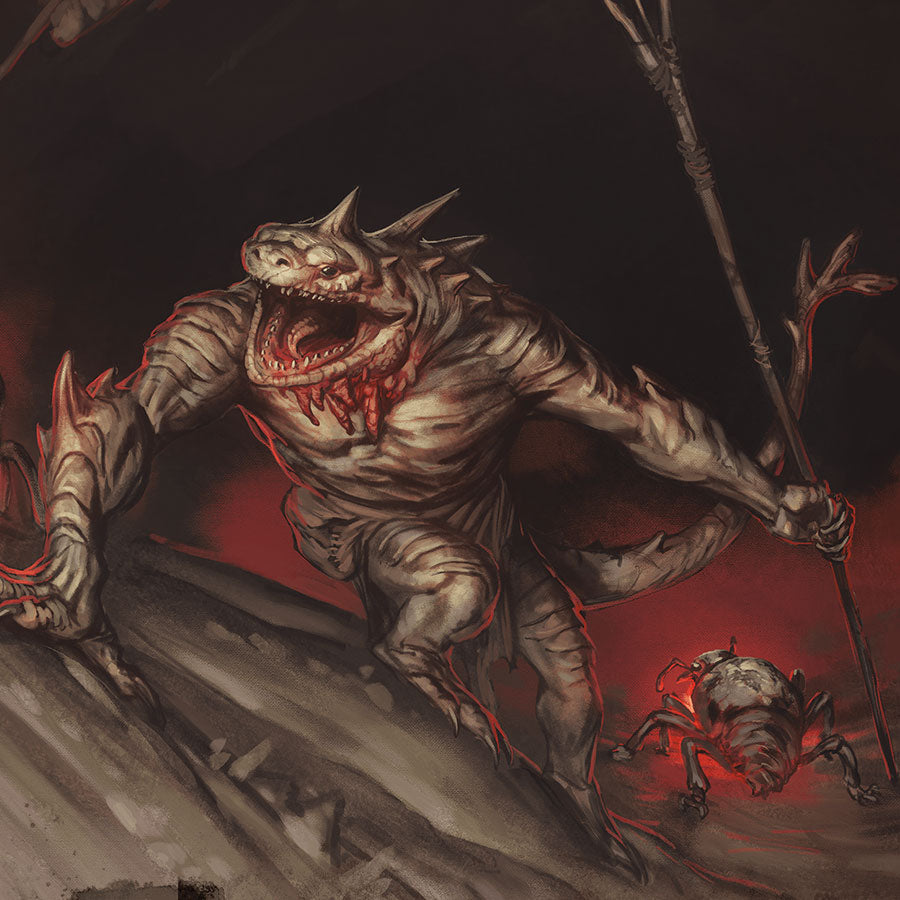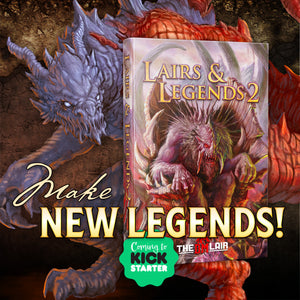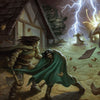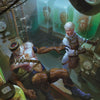This DM Made Every Mistake in the Book

Written by Luke Hart
Today we’re talking about an experienced game master named Darren. Now he was a solid GM with years of experience, but this night his game crashed and burned in a blaze of awkward roleplay, botched encounters, and frustrated players. You see, Darren was guilty of committing 10 bad game master habits that individually might just be annoying, but combined doomed his game to failure.
By the way, if you're looking for a low level pre-made adventure module for your D&D 5e game, I highly recommend Into the Fey. It's designed for levels 1 to 5, features tricksy fey and their sly schemes, and contains everything you need to play!
Watch or listen to this article by clicking the video below.
Now, Darren was running a homebrew Dungeons & Dragons campaign called Echoes of the Shadowmarch. His players included:
- Kayla, a half-elf sorcerer always hungry for lore.
- Marcus, a human fighter who lived for combat.
- Trent, a halfling rogue with a knack for causing extra problems.
- Leah, a dwarf cleric who kept the party alive with sheer grit.
The session began in the cursed wilderness of the Shaded Glade. Their quest? Escort an elven diplomat through monster-infested woods to the ruined city of Velvinar.
Mistake #1: Doesn’t Give the Players Time to Stew
Right out of the gate, the party was ambushed by monstrous vinebeasts. Spells flew, weapons clashed, and they barely scraped by. And after the fight ended, there was this tense silence, as the players reassessed and considered their next moves.
Now, this was good tension—the kind where players are thinking, plotting their next move... but Darren couldn’t handle the quiet, the pause at the table. So, he jumped in, forcing another encounter with ‘stalking predators.’ His players were still strategizing when the new threat hit, killing the mood entirely.
The thing is, you don’t need to fill every awkward silence. It may seem like if nothing is happening, you’re not doing your job, but sometimes, players need time to stop and think or to discuss things among themselves, and sometimes, this will lead to “awkward” silence. And that’s okay.
Do your best to gauge the difference between constructive silence and the game stalling... the latter is bad, but the former allows players time to gather their thoughts, come up with cool ideas, and promotes engagement.
Mistake #2: Runs Long NPC Scenes
Later, the party stumbled upon a long-forgotten forest shrine bathed in ghostly moonlight. It was supposed to be an eerie discovery filled with mystery.
But Darren had been working on this cool ancient forest spirit voice, had some custom artwork for it, and even a bit of backstory—he just couldn’t resist. He launched into a ten-minute solo performance as an ancient forest spirit, shifting voices and recounting the entire history of the ruined city in painful detail. Marcus was literally rolling dice to stay awake.
What should’ve been two sentences of background with more information available upon request became a full one-sided lore documentary. Players were tuned out by the time the actual plot hook arrived.
NPC scenes such as these, also known as “NPC Theater” or “Theater Major GMs,” usually play out as extended scenes between two or more NPCs, usually switching between voices and personas and giving long descriptions and, often, backstory lore dumps that are irrelevant to the campaign.
A better way to do this is to summarize the scene with the information the characters can learn OR, even better, roleplay it out with one NPC, but only present enough information to get your players interested. Their characters will then ask questions, allowing the NPC to doll out more information. Then you end up with a social interaction scene that engages the players instead of a boring lore dump and GM Theater Major performance.
Mistake #3: Justifying Everything the Monsters Do
The next combat was against corrupted treants who targeted Leah’s cleric exclusively. Darren explained that ‘The treants hate divine light and are drawn to her holy aura!’ Now, as a one-off explanation for monster actions that don’t make1 sense, okay maybe. But the thing here is that Darren did this A LOT in the game session. He was constantly justifying every single action the monsters took.
It personally drives me crazy when the GM has to explain why the monster is choosing to take the action they’re about to take every time the monster acts. Sometimes, yes, it’s good to explain why a monster is doing something that seems illogical, but some GMs take it too far. I mean, players don’t have to justify every action they take? Why should GMs?
Mistake #4: Deus Ex Machina
After barely surviving the forest, they reached the crumbling gates of Velvinar, where Darren’s big boss encounter awaited: Eryndis the Thorn Queen, a deadly archfey corrupted by shadow magic.
The fight was intense. Kayla’s sorcerer got knocked unconscious, Leah was out of spell slots, Marcus was bleeding out, and things looked dire—as they should in a final boss fight!
However, instead of allowing the dice to fall as they may and the story to play itself out naturally, Darren panicked. He didn’t want anyone to die! After all, wouldn’t that make him a bad game master?
So, he dropped in a friendly NPC, Elandor the Ranger, who just happened to be exploring the city himself. Elandor heroically saved the group with a perfectly timed heal—I didn’t even know rangers COULD heal—and the characters barely survived. However, their victory felt hollow…as well it should.
Saving the players’ bacon, also known as the Deus Ex Machina, results in a game with no sense of danger or urgency.
Games like this may manifest as constant free resurrections where nobody ever stays dead because the GM either feels guilty or because they’ve made the campaign too dependent upon one or more player characters.
Or the GM may just go out of their way to prevent character deaths or TPKs. Nobody ever dies or feels like they may die because the GM will always rescue them or bail them out.
The problem is this results in a complete lack of tension in the game. And when players know there is no chance for failure, their victories don’t seem so grand. They don’t seem like a reward at all.
Mistake #5: Too Stingy or Too Generous with Loot
After this harrowing fight, Darren gave the party a single enchanted cloak woven from forest shadows as their spoils of battle. Its magic effect was minor, and it only fit Kayla’s sorcerer. Needless to say, the group felt cheated. After surviving that—even if technically they only survived because of their NPC savior—they expected something more meaningful.
Sure, being too stingy with loot CAN be a problem, but let’s be honest most GMs trend toward giving out TOO MUCH loot, not too little. And while not enough loot disappoints players, too much loot can unbalance the game and create more work for the game master. So, my recommendation is usually to follow the treasure distribution rules of the game system you’re using. But if you’re going to get crazy, it’s better to give out too little and then later make up for it. Because once you give out too much loot, it’s hard to put that cat back in the bag.
Mistake #6: Being Inconsistent with the Rules
Now, during the fight with the Thorn Queen, Marcus had wanted to climb a crumbling tower, and Darren had let him do it without a roll. However, once the fight was over, when Trent’s rogue wanted to do climb the tower to search for more loot that they may have overlooked, Darren asked for an Acrobatics check. And, of course, the rogue rolled a natural 1, failing spectacularly, and took falling damage. And at that moment, Kayla reminded everyone that Marcus hadn’t needed a roll. The next 15 minutes were not fun for Darren.
Look, this isn’t rocket science. If you make a rules call for one player, that same call should apply to everyone. Furthermore, if you KNOW and PLAY by the rules, this will come up less often. But when you’re just winging everything, you’re inevitably going to screw this up and players will rightfully not take kindly to it.
Now, if you’re going to make a rules call that only applies once, because of a particularly dramatic moment or well-played scene, explain in the moment that this is a one-time exception. Furthermore, be prepared to make other exceptions when similar events happen in the future to avoid accusations of favoritism.
Mistake #7: Using the Game to Discipline the Players
Here’s where Darren really messed up. Trent’s rogue had been acting... let’s say extra disruptive the whole game. Stealing from NPCs, pocketing loot but not telling the other characters—even though the other players knew—anyway, you know the type. We’ve probably all had players like that in our games.
So, when Trent wandered off alone, Darren intentionally hit him with a, well, let’s just call it a deathtrap encounter, and there was not questioning that it was designed to punish him. There was no story reason, no fairness, just pure GM spite, vengeance, or whatever.
Look, whether it’s a personal issue, an issue with the way a player plays, a concern about cheating, or anything else that makes you upset or angry, a GM should never, EVER use their power as the Game Master to punish players for something outside of the narrative. Consequences for in character actions are fine... recommended even. Punishment for “player crimes,” however, are not okay. Those should be discussed and resolved outside of the narrative.
Mistake #8: Doesn’t Prep Enough
Something that became clear to all the players over the course of the game session was that Darren hadn’t prepped nearly enough. Encounters felt random, important NPCs didn’t have names, narrative descriptions all felt bland and similar, and the loot seemed like it was rolled on a random table on the spot.
Now, I’m not attacking Sly Flourish here—he’s a great guy and I love his work—but don’t be a lazy dungeon master. I mean, sure, be Sly Flourish lazy if his methodologies work for you, but don’t be lazy in the sense of preparing almost nothing and pulling everything out of your butt in the moment. That rarely works out well. The real key is to know yourself. Know how much preparation you need to run a good game.
Mistake #9: Trying to Run for Too Many Players
To top everything off, Darren was running the game for nine players. With that many players, combat had slowed to a crawl, players were frustrated by the lack of time in the spotlight—or to just play at all—and side-conversations and disruptions abounded.
But wait, you may be saying, you said there were just four players. Yeah, I know. I lied. What can I say, I’m a bad person.
Look, I know that sometimes it’s hard to find players, so when a GM has an influx of players, you may try to accommodate all of them. Or you may just feel bad having to turn people away. However, I’ve been in games with large groups of players, and they are rarely that great.
However, I will say that different game systems deal better with large groups than others. For instance, D&D 5e and Pathfinder 2e are NOT good for large groups; whereas Shadowdark handles larger groups much better. My inclination is to say that rules-heavy systems probably don’t handle larger groups well, but rules-light systems will tend to be better at them.
Mistake #10: Forgets What It’s Like to Be a Player
Something that Darren did really well for the game session was that he fleshed out an extensive and interesting backstory and lore about Velvinar’s fall. In fact, his story was packed with clever clues, bits of lore here and there; however, none of the players seemed to catch onto them. This proved particularly problematic when they needed some of these bits of lore to solve a puzzle, and resulting in the puzzle being a real slog.
You see, Darren had forgotten what it’s like to be a player. He forgot that the players don’t know everything that he knew. He assumed that the hints and clues he was giving were obvious.
Now, you don’t have to “baby” your players but give them a break sometimes. Be willing to throw your players a bone in a difficult challenge or mystery. Let them have time to heal and recover during long strings of encounters. And remember to let them feel cool, victorious, and heroic.
After all, that’s what the game is all about.
Confront Devious Fey and Their Tricksy Plots!
For years, the fey creatures inhabiting Pelview Grove to the north and Pelfell Bog to the east have not been a source of trouble, though perhaps they were a shade too mischievous at times. That has now changed.
Beset on all sides by a variety of issues -- childish pranks gone wild, dwarves forced out of their own brewery, and farmers missing -- the Aeredale guard is looking for help from local adventuring parties to set things right.
For those brave souls who accept the call to adventure, it'll be time to go into the fey.
If you’re looking to start up a new 5e campaign or reboot your current one, Into the Fey may be exactly what you need. Designed for levels 1 to 5, Into the Fey contains everything you need to start playing:
- Eleven fey-themed adventures for level 1 to 5 adventuring parties
- Over 40 new fey monsters
- The fully fleshed-out town of Aeredale
- Maps of Aeredale, the surrounding region, and the Fey Plane
- Player handouts
- Hag potion system
- 15 new fey magic items
- JPG image files of all Into the Fey adventure maps, including GM versions and gridded/non-gridded player versions
- JPG images files of all Into the Fey world maps
- Digital tokens of Into the Fey NPCs and monsters
Pick up the Into the Fey Ultimate Bundle to get the hardcover, the PDF, digital maps, and digital tokens.
Starting a new campaign can be tons of work; let Into the Fey do some of the heavy lifting for you!
-
Posted in
Game Master How-To Articles







